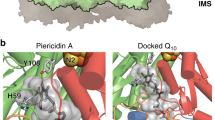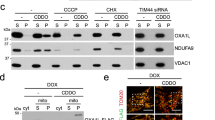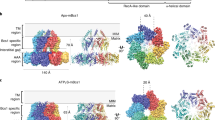Abstract
MIA40 has a key role in oxidative protein folding in the mitochondrial intermembrane space. We present the solution structure of human MIA40 and its mechanism as a catalyst of oxidative folding. MIA40 has a 66-residue folded domain made of an α-helical hairpin core stabilized by two structural disulfides and a rigid N-terminal lid, with a characteristic CPC motif that can donate its disulfide bond to substrates. The CPC active site is solvent-accessible and sits adjacent to a hydrophobic cleft. Its second cysteine (Cys55) is essential in vivo and is crucial for mixed disulfide formation with the substrate. The hydrophobic cleft functions as a substrate binding domain, and mutations of this domain are lethal in vivo and abrogate binding in vitro. MIA40 represents a thioredoxin-unrelated, minimal oxidoreductase, with a facile CPC redox active site that ensures its catalytic function in oxidative folding in mitochondria.
This is a preview of subscription content, access via your institution
Access options
Subscribe to this journal
Receive 12 print issues and online access
$189.00 per year
only $15.75 per issue
Buy this article
- Purchase on Springer Link
- Instant access to full article PDF
Prices may be subject to local taxes which are calculated during checkout








Similar content being viewed by others
References
Gruber, C.W., Cemazar, M., Heras, B., Martin, J.L. & Craik, D.J. Protein disulphide isomerase: the structure of oxidative folding. Trends Biochem. Sci. 31, 455–464 (2006).
Hatahet, F. & Ruddock, L.W. Substrate recognition by the protein disulfide isomerases. FEBS J. 274, 5223–5234 (2007).
Sevier, C.S. & Kaiser, C.A. Ero1 and redox homeostasis in the endoplasmic reticulum. Biochim. Biophys. Acta 1783, 549–556 (2008).
Collet, J.F. & Bardwell, J.C. Oxidative protein folding in bacteria. Mol. Microbiol. 44, 1–8 (2002).
Kadokura, H., Katzen, F. & Beckwith, J. Protein disulfide bond formation in prokaryotes. Annu. Rev. Biochem. 72, 111–135 (2003).
Nakamoto, H. & Bardwell, J.C. Catalysis of disulfide bond formation and isomerization in the Escherichia coli periplasm. Biochim. Biophys. Acta 1694, 111–119 (2004).
Chacinska, A. et al. Essential role of Mia40 in import and assembly of mitochondrial intermembrane space proteins. EMBO J. 23, 3735–3746 (2004).
Lu, H., Allen, S., Wardleworth, L., Savory, P. & Tokatlidis, K. Functional TIM10 chaperone assembly is redox-regulated in vivo. J. Biol. Chem. 279, 18952–18958 (2004).
Mesecke, N. et al. A disulfide relay system in the intermembrane space of mitochondria that mediates protein import. Cell 121, 1059–1069 (2005).
Tokatlidis, K. A disulfide relay system in mitochondria. Cell 121, 965–967 (2005).
Allen, S., Balabanidou, V., Sideris, D.P., Lisowsky, T. & Tokatlidis, K. Erv1 mediates the Mia40-dependent protein import pathway and provides a functional link to the respiratory chain by shuttling electrons to cytochrome c. J. Mol. Biol. 353, 937–944 (2005).
Bihlmaier, K. et al. The disulfide relay system of mitochondria is connected to the respiratory chain. J. Cell Biol. 179, 389–395 (2007).
Dabir, D.V. et al. A role for cytochrome c and cytochrome c peroxidase in electron shuttling from Erv1. EMBO J. 26, 4801–4811 (2007).
Rissler, M. et al. The essential mitochondrial protein Erv1 cooperates with Mia40 in biogenesis of intermembrane space proteins. J. Mol. Biol. 353, 485–492 (2005).
Naoe, M. et al. Identification of Tim40 that mediates protein sorting to the mitochondrial intermembrane space. J. Biol. Chem. 279, 47815–47821 (2004).
Terziyska, N. et al. Mia40, a novel factor for protein import into the intermembrane space of mitochondria is able to bind metal ions. FEBS Lett. 579, 179–184 (2005).
Hofmann, S. et al. Functional and mutational characterization of human MIA40 acting during import into the mitochondrial intermembrane space. J. Mol. Biol. 353, 517–528 (2005).
Gabriel, K. et al. Novel mitochondrial intermembrane space proteins as substrates of the MIA import pathway. J. Mol. Biol. 365, 612–620 (2007).
Cobine, P.A., Pierrel, F. & Winge, D.R. Copper trafficking to the mitochondrion and assembly of copper metalloenzymes. Biochim. Biophys. Acta 1763, 759–772 (2006).
Banci, L. et al. Mitochondrial copper(I) transfer from Cox17 to Sco1 is coupled to electron transfer. Proc. Natl. Acad. Sci. USA 105, 6803–6808 (2008).
Banci, L. et al. Modeling protein-protein complexes involved in the cytochrome c oxidase copper-delivery pathway. J. Proteome Res. 6, 1530–1539 (2007).
Bauer, M.F., Hofmann, S., Neupert, W. & Brunner, M. Protein translocation into mitochondria: the role of TIM complexes. Trends Cell Biol. 10, 25–31 (2000).
Endres, M., Neupert, W. & Brunner, M. Transport of the ADP/ATP carrier of mitochondria from the TOM complex to the TIM22.54 complex. EMBO J. 18, 3214–3221 (1999).
Vial, S. et al. Assembly of Tim9 and Tim10 into a functional chaperone. J. Biol. Chem. 277, 36100–36108 (2002).
Sevier, C.S. & Kaiser, C.A. Conservation and diversity of the cellular disulfide bond formation pathways. Antioxid. Redox Signal. 8, 797–811 (2006).
Tu, B.P. & Weissman, J.S. Oxidative protein folding in eukaryotes: mechanisms and consequences. J. Cell Biol. 164, 341–346 (2004).
Wilkinson, B. & Gilbert, H.F. Protein disulfide isomerase. Biochim. Biophys. Acta 1699, 35–44 (2004).
Milenkovic, D. et al. Biogenesis of the essential Tim9-Tim10 chaperone complex of mitochondria: site-specific recognition of cysteine residues by the intermembrane space receptor Mia40. J. Biol. Chem. 282, 22472–22480 (2007).
Muller, J.M., Milenkovic, D., Guiard, B., Pfanner, N. & Chacinska, A. Precursor oxidation by Mia40 and Erv1 promotes vectorial transport of proteins into the mitochondrial intermembrane space. Mol. Biol. Cell 19, 226–236 (2008).
Sideris, D.P. & Tokatlidis, K. Oxidative folding of small Tims is mediated by site-specific docking onto Mia40 in the mitochondrial intermembrane space. Mol. Microbiol. 65, 1360–1373 (2007).
Webb, C.T., Gorman, M.A., Lazarou, M., Ryan, M.T. & Gulbis, J.M. Crystal structure of the mitochondrial chaperone TIM9.10 reveals a six-bladed α-propeller. Mol. Cell 21, 123–133 (2006).
Sharma, D. & Rajarathnam, K. 13C NMR chemical shifts can predict disulfide bond formation. J. Biomol. NMR 18, 165–171 (2000).
Grumbt, B., Stroobant, V., Terziyska, N., Israel, L. & Hell, K. Functional characterization of Mia40p, the central component of the disulfide relay system of the mitochondrial intermembrane space. J. Biol. Chem. 282, 37461–37470 (2007).
Wishart, D.S. & Sykes, B.D. The 13C chemical shift index: a simple method for the identification of protein secondary structure using 13C chemical shift data. J. Biomol. NMR 4, 171–180 (1994).
Dominguez, C., Boelens, R. & Bonvin, A.M. HADDOCK: a protein-protein docking approach based on biochemical or biophysical information. J. Am. Chem. Soc. 125, 1731–1737 (2003).
Banci, L. et al. A structural-dynamical characterization of human Cox17. J. Biol. Chem. 283, 7912–7920 (2008).
Kadokura, H., Tian, H., Zander, T., Bardwell, J.C. & Beckwith, J. Snapshots of DsbA in action: detection of proteins in the process of oxidative folding. Science 303, 534–537 (2004).
Qin, J., Clore, G.M., Kennedy, W.P., Kuszewski, J. & Gronenborn, A.M. The solution structure of human thioredoxin complexed with its target from Ref-1 reveals peptide chain reversal. Structure 4, 613–620 (1996).
Keller, R. The Computer Aided Resonance Assignment Tutorial (Cantina, Goldau, 2004).
Guntert, P. Automatd NMR structure calculation with CYANA. Methods Mol. Biol. 278, 353–378 (2004).
Herrmann, T., Güntert, P. & Wüthrich, K. Protein NMR structure determination with automated NOE assignment using the new software CANDID and the torsion angle dynamics algorithm DYANA. J. Mol. Biol. 319, 209–227 (2002).
Herrmann, T., Güntert, P. & Wüthrich, K. Protein NMR structure determination with automated NOE-identification in the NOESY spectra using the new software ATNOS. J. Biomol. NMR 24, 171–189 (2002).
Eghbalnia, H.R., Wang, L., Bahrani, A., Assadi, A. & Markley, J.L. Protein energetic conformational analysis from NMR chemical shifts (PECAN) and its use in determining secondary structural elements. J. Biomol. NMR 32, 71–81 (2005).
Case, D.A. et al. AMBER 8.0, (San Francisco, CA, University of California 2004).
Laskowski, R.A., Rullmann, J.A.C., MacArthur, M.W., Kaptein, R. & Thornton, J.M. AQUA and PROCHECK-NMR: programs for checking the quality of protein structures solved by NMR. J. Biomol. NMR 8, 477–486 (1996).
Vriend, G. WHAT IF: a molecular modeling and drug design program. J. Mol. Graph. 8, 52–56 (1990).
Farrow, N.A. et al. Backbone dynamics of a free and phosphopeptide-complexed Src homology 2 domain studied by 15N NMR relaxation. Biochemistry 33, 5984–6003 (1994).
Grzesiek, S. & Bax, A. The importance of not saturating H2O in protein NMR. Application to sensitivity enhancement and NOE measurements. J. Am. Chem. Soc. 115, 12593–12594 (1993).
Schagger, H. & Von Jagow, G. Blue native electrophoresis for isolation of membrane protein complexes in enzymatically active form. Anal. Biochem. 199, 223–231 (1991).
Pettersen, E.F. et al. UCSF Chimera—a visualization system for exploratory research and analysis. J. Comput. Chem. 25, 1605–1612 (2004).
Banci, L. et al. Human Sco1 functional studies and pathological implications of the P174L mutant. Proc. Natl. Acad. Sci. USA 104, 15–20 (2007).
Acknowledgements
We are grateful to A. Makris (Mediterranean Agronomic Institute of Chania, Crete) for the plasmid M4801, N. Pfanner (University of Freiburg) for the porin SP6 plasmid, N. Petrakis (K.T. laboratory, Institute of Molecular Biology and Biotechnology-Foundation for Research and Technology (IMBB-FORTH)) for help with the use of the Chimera software used in Figure 5, A. Hatzi (K.T. group, IMBB-FORTH) for some help with part of the mutagenesis and T. Economou (IMBB-FORTH) and T. Pugsley (Institut Pasteur) for comments on the manuscript. This work was supported by European Network of Research Infrastructures for Providing Access and Technological Advancements in Bio-NMR Contract 026145, by the SPINE II-COMPLEXES Contract, LSHG-CT-2006-031220 “From Receptor to Gene: Structures of Complexes from Signalling Pathways Linking Immunology, Neurobiology and Cancer,” and by funds from IMBB-FORTH, the University of Crete and the European Social Fund and National Resources (to K.T.). D.P.S. was supported by a PENED grant. This work was also supported in part by the Italian MIUR-FIRB (Fondo per gli Investimenti della Ricerca di Base, Grant protocollo, MIUR-RBLA032ZM7). Molecular graphics images were produced using the UCSF Chimera package50 from the Resource for Biocomputing, Visualization, and Informatics at the University of California, San Francisco (supported by the US National Institutes of Health grant P41 RR-01081).
Author information
Authors and Affiliations
Contributions
I.B. and L.B. planned the research, discussed and guided the flow of experiments and coordinated the writing of the text, to which all the co-authors contributed; M.M. and C.C. coordinated and performed protein production and characterization; A.G. solved the MIA402S-S NMR structure; S.C.-B. planned and recorded the NMR spectra and coordinated the titration experiments; D.P.S. performed the in vivo and in vitro mutational analysis and interactions and analyzed data; N.K. provided technical support; K.T. designed experiments, analyzed data and coordinated the presentation of the data and the writing of the paper.
Corresponding authors
Supplementary information
Supplementary Text and Figures
Supplementary Figures 1–6 and Supplementary Methods (PDF 2140 kb)
Rights and permissions
About this article
Cite this article
Banci, L., Bertini, I., Cefaro, C. et al. MIA40 is an oxidoreductase that catalyzes oxidative protein folding in mitochondria. Nat Struct Mol Biol 16, 198–206 (2009). https://doi.org/10.1038/nsmb.1553
Received:
Accepted:
Published:
Issue Date:
DOI: https://doi.org/10.1038/nsmb.1553
This article is cited by
-
Small heat shock proteins operate as molecular chaperones in the mitochondrial intermembrane space
Nature Cell Biology (2023)
-
Copper metabolism in Saccharomyces cerevisiae: an update
BioMetals (2021)
-
The C-terminal region of the oxidoreductase MIA40 stabilizes its cytosolic precursor during mitochondrial import
BMC Biology (2020)
-
CHCHD4 confers metabolic vulnerabilities to tumour cells through its control of the mitochondrial respiratory chain
Cancer & Metabolism (2019)
-
Erv1 of Arabidopsis thaliana can directly oxidize mitochondrial intermembrane space proteins in the absence of redox-active Mia40
BMC Biology (2017)



